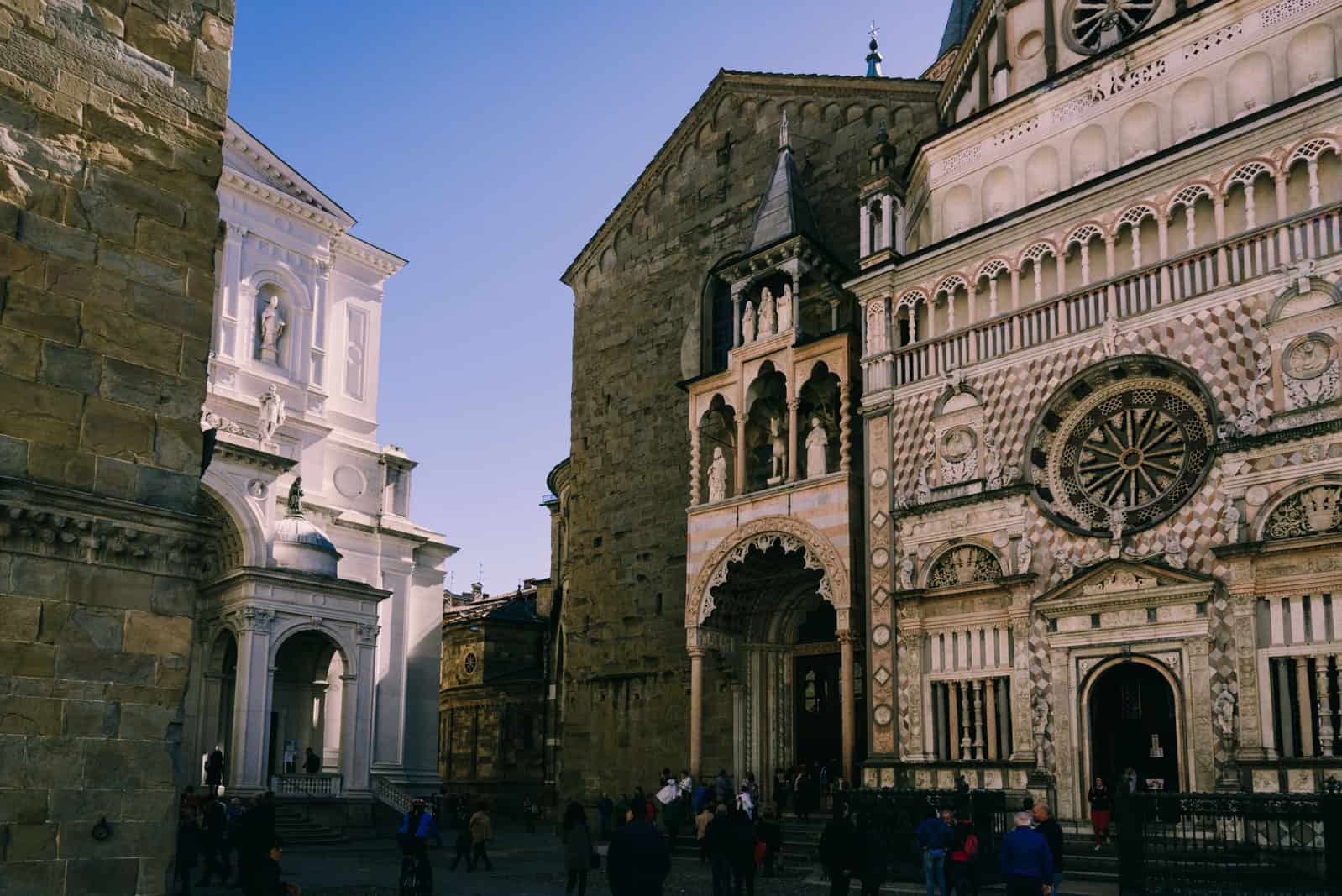Travel guide | Lombardy | Italy
3-day Lombardy Itinerary:
Como, Bergamo, and Brescia
Text | Anninka Kraus
Photography | Tobias Kraus

Italy Lombardy
It was two weeks before Easter when we finally decided on a tour of three cities in Lombardy, Northern Italy – Como, Bergamo, and Brescia. This is an area strewn with well-preserved historic townscapes enclosed by old city walls, medieval castles, and Roman ruins, which add history, culture and diverse architecture to a landscape already rich in scenery.
In Lombardy, lakes are bordered by steep limestone cliffs that in summer are thickly blanketed in greenery, vineyards dot the territory of Franciacorta that is a well-known, DOC-protected wine region (Denominazione die origine controllata) cultivating Chardonnay and Pinot grapes in the Province of Brescia where Lake Iseo is located, and tiny townships huddle around stout medieval steeples bearing cast iron church bells that resound in a playful melody instead of the monotonous dingdong that we’re used to.
My former Italian colleagues had gushed over Bergamo and we’d already been to Como many times, so we chose Bergamo as our home base for three nights. The only thought shortly dampening our excitement was that of many hours stuck in the inevitable traffic jams forming on every single road leading south (and on the return trip heading north) that anyone who’s ever travelled in the direction of Italy at Easter has likely endured. The following year one will either feign forgetfulness and join the line of cars again or take the train. We opted for the latter and counted ourselves lucky that there were some remaining seats on the train to Milano on Friday noon.
But irrespective of the traffic jams, train travel to Italy has become more attractive in any case with the opening of the new Gotthard Base Tunnel in 2016 that connects the Cantons of Uri in the north with Ticino, the only Italian speaking Canton of Switzerland bordering on Italy in the south. The 57km long train tunnel runs underneath the Swiss Alp and is the world’s largest railway tunnel, reducing the journey from Zurich to Milan by 30-40min.
Perched on uncomfortably narrow seats on the Italian Trenitalia train, we were hoping to escape the dreary grey cloud cover in the north by disappearing into the tunnel’s blackness and 20min later escape into bright sunshine. That was the plan anyway but instead raindrops smeared the windows and visibility was reduced to wafts of mist hanging low in the valley that obscured the view of the surrounding mountain scenery when the train excited the tunnel near Bodio. By the time we pulled up at the station in Como not long after however, the rain had stopped and patches of blue sky allowed occasional glimpses of the sun.
The downside of train travel, the reduced mobility at our destination, was easily remedied by hiring a rental car. In Como three large car rental agencies – Europcar, Avis, and Budget – are situated on Via Innocenzo XI, a few minutes’ walk from Como San Giovanni train station, and another agency, Hertz, is located right inside the station. As there’s no luggage deposit at the station, the rental agency kindly offered to keep ours for a few hours as we strolled through Como for the first time this year, grabbed toasted paninis stuffed with Parma ham, rocket, and dried tomato or veggies, burrata and pistachios at Tigella Bella and rounded this off with the first Italian gelato of the season at Gelateria Lariana along the lakefront.
Lombardy 3-day Itinerary
Discover Como on a beautiful Lakeside Walk
Discover elegant piazzas and Roman remains on a city walk in Brescia
Explore rural Lombardy near Ambivere
jump ahead.
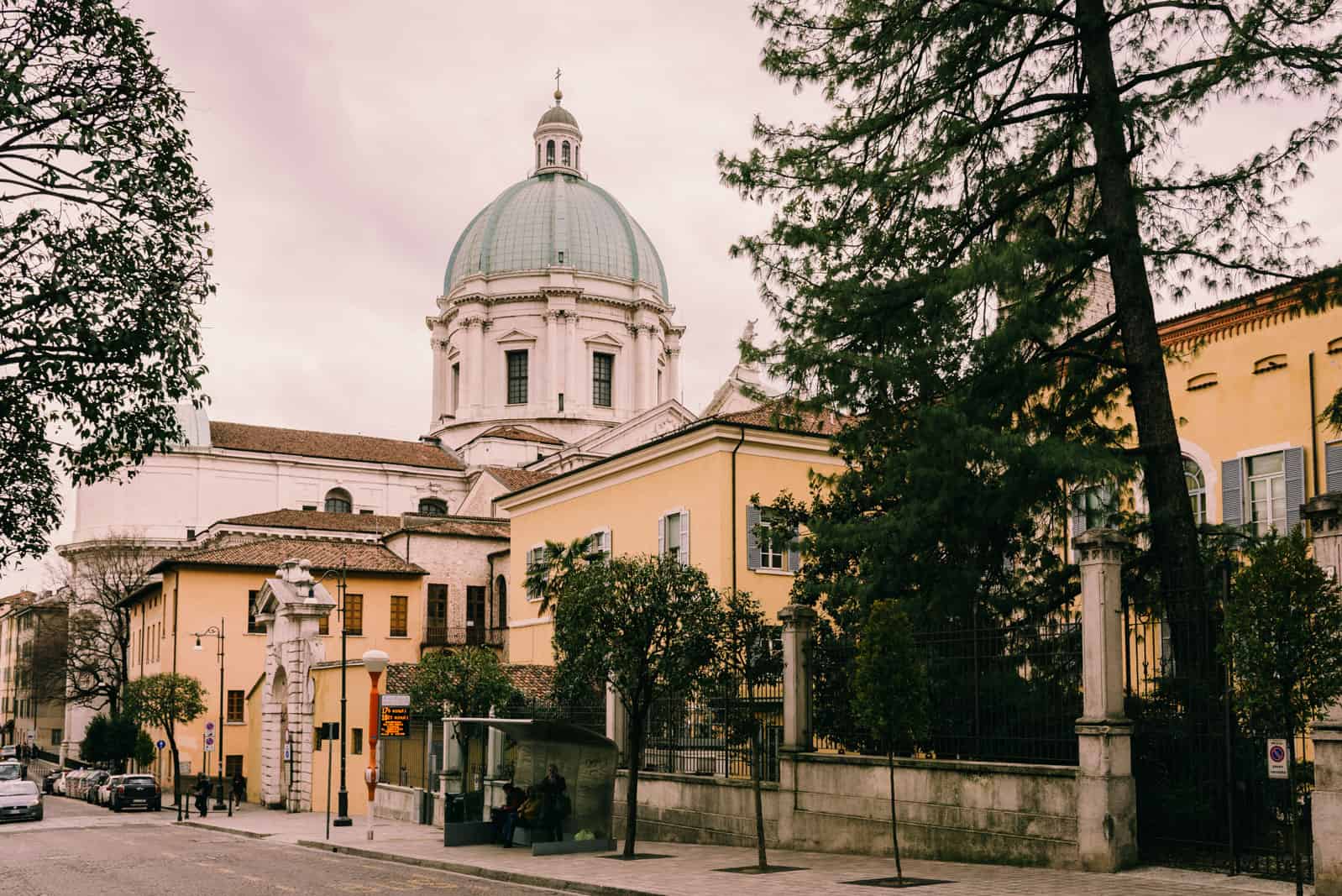
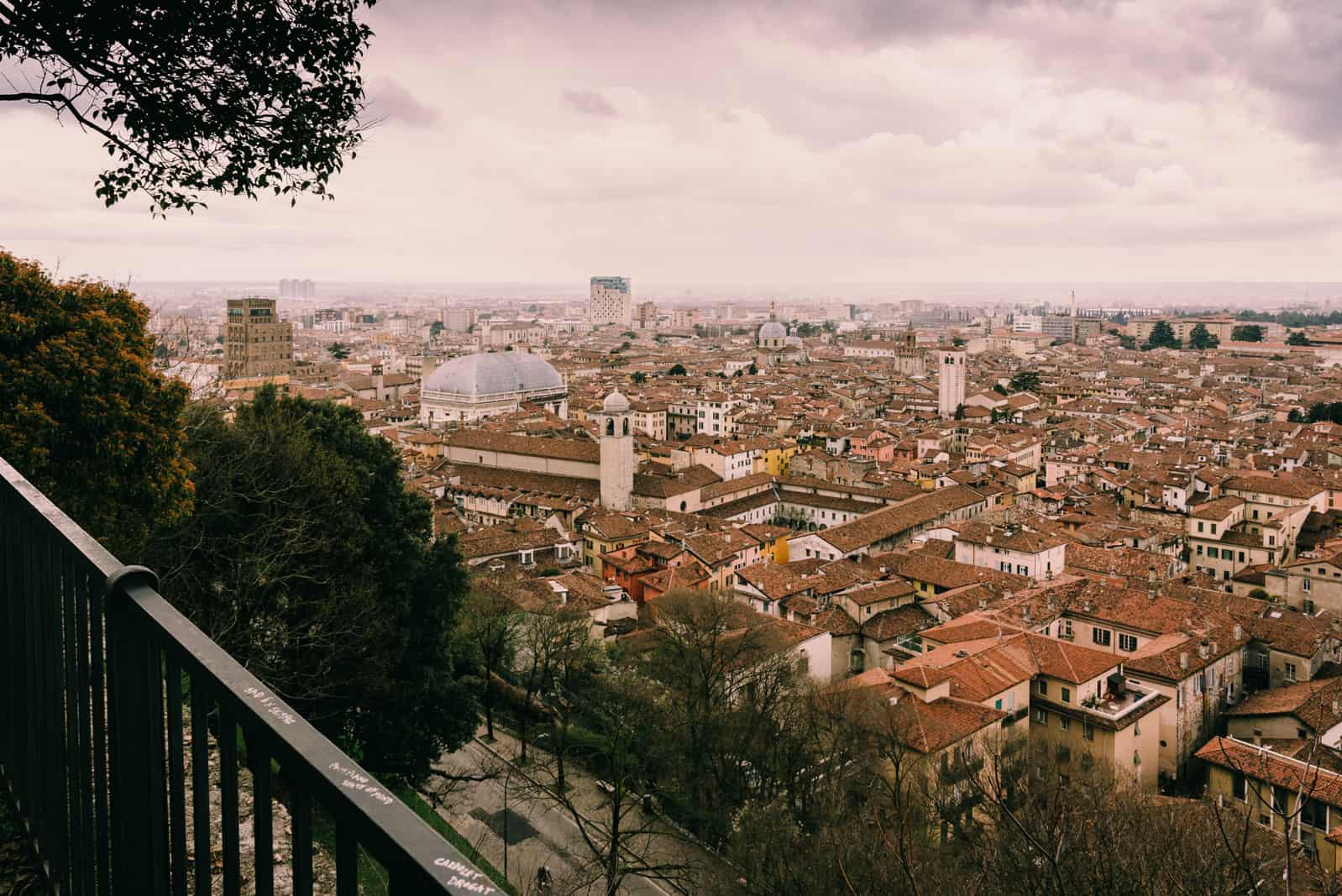
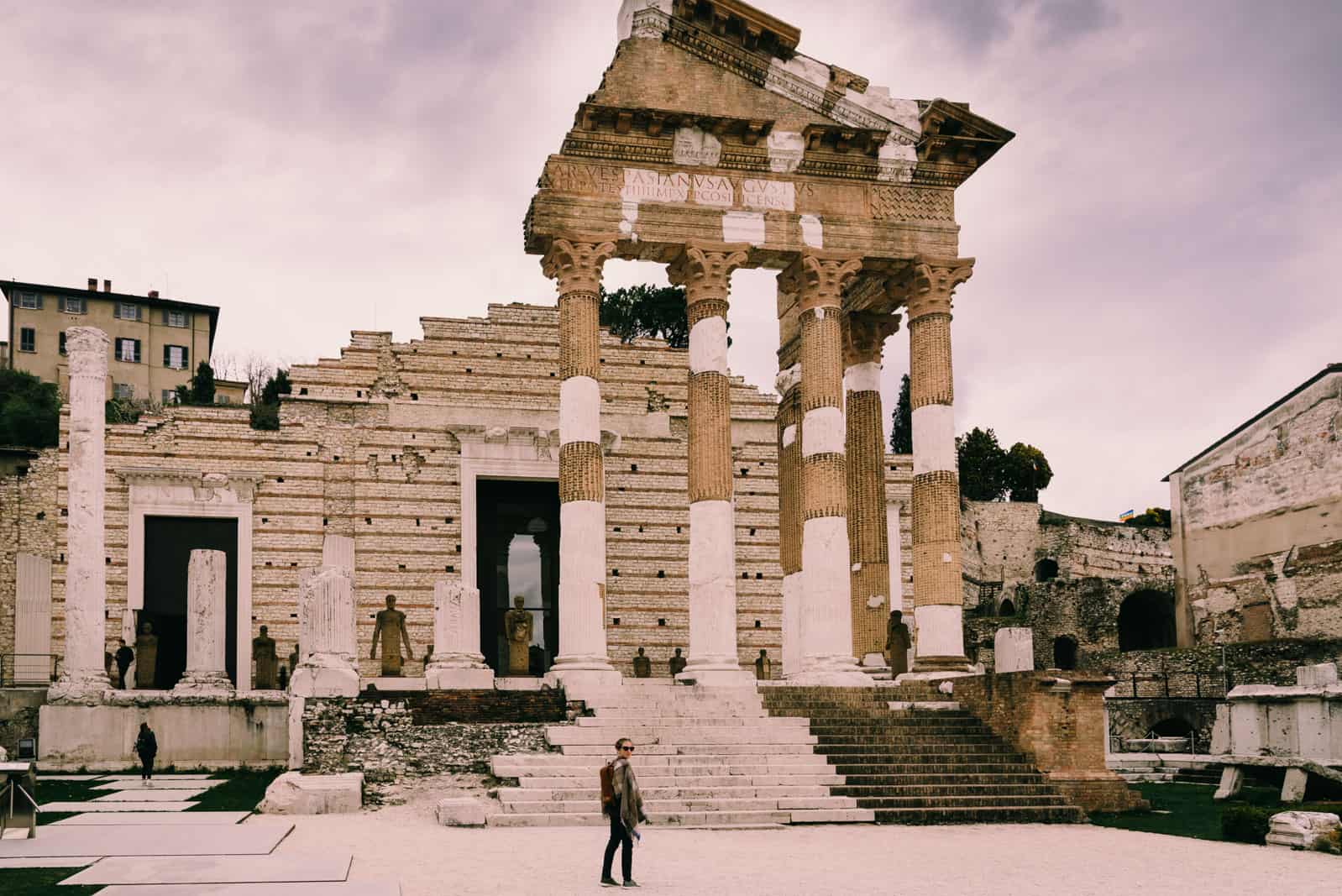
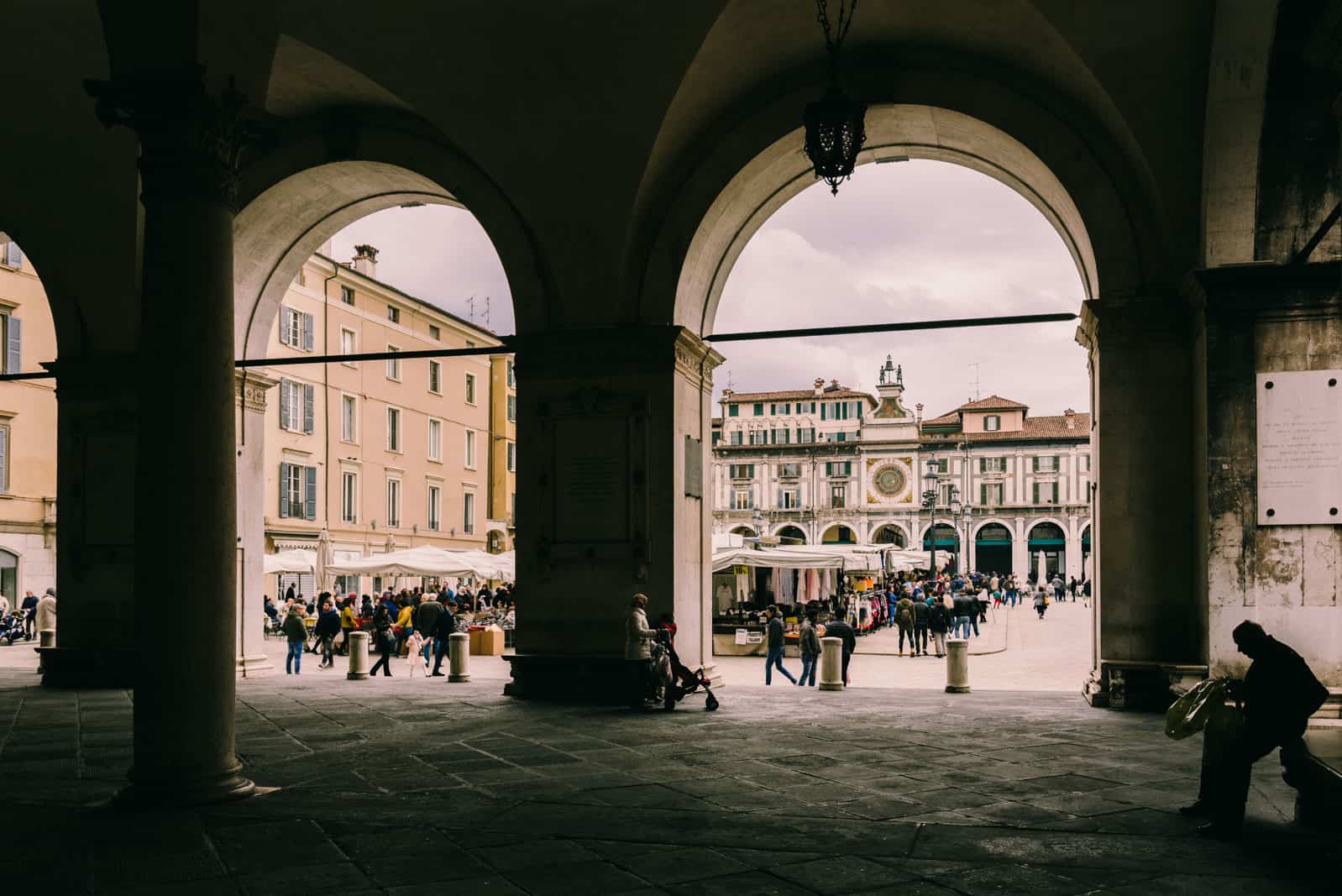




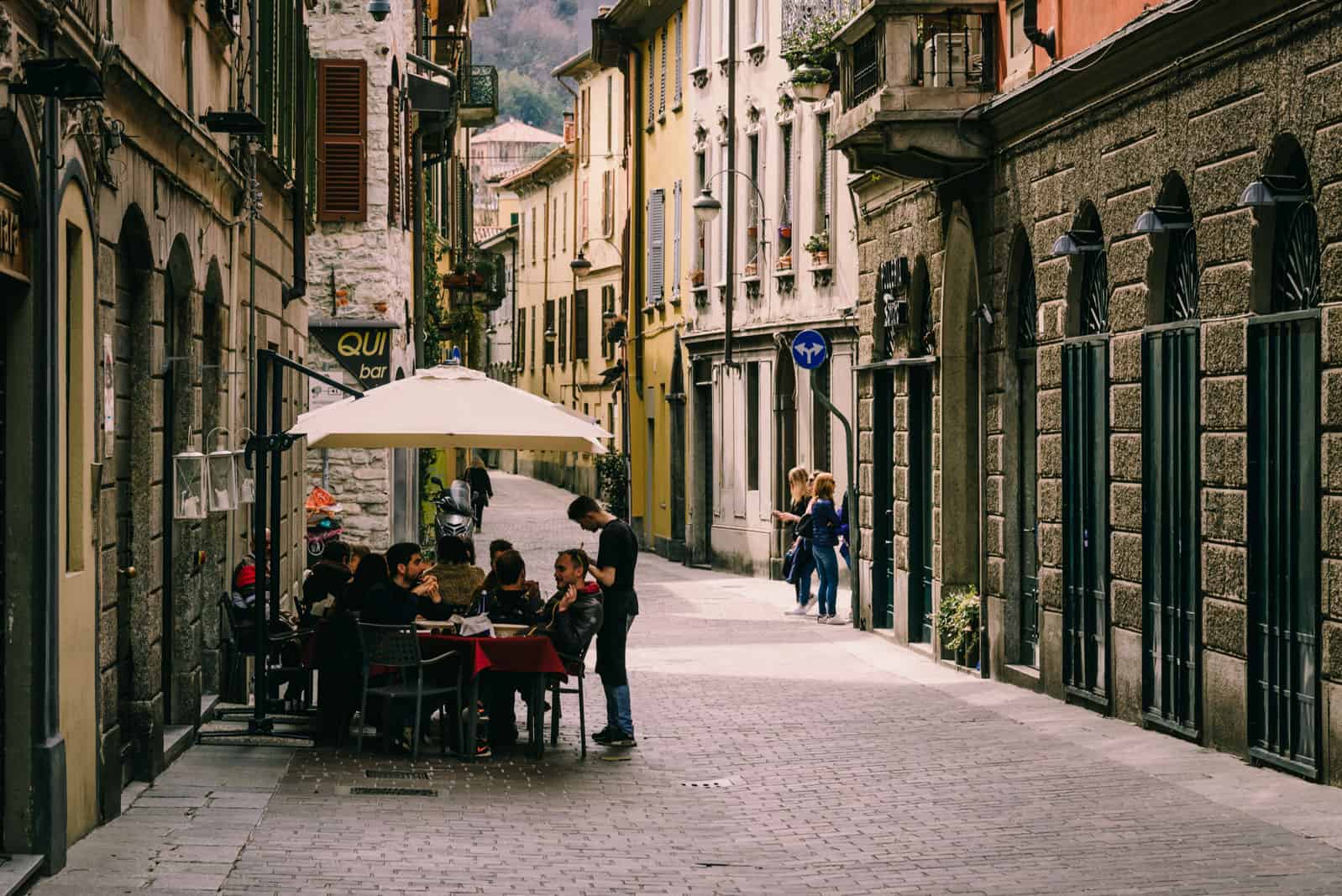


what to expect.
An area strewn with well-preserved historic townscapes enclosed by old city walls, medieval castles, and Roman ruins
Lakes bordered by steep limestone cliffs that in summer are thickly blanketed in greenery
Tiny townships that huddle around stout medieval steeples bearing cast iron church bells
Vineyards and pastures, thick woods and cobble stone paths in rural Lombardy
Lakeside walk | Como
Walk | Point-to-point trail | 2.3km
Como
Como on Good Friday was as charming as ever, despite being very crowded with mostly Italian visitors over the Easter weekend. The narrow cobble stone alleyways and busy piazzas framed by sidewalk tables, grand villas set in park like surroundings behind impressive cast-iron gates, and the Duomo – a cathedral, its beginnings dating back to the 14th century – are all within easy walking distance in this carefully restored historic city centre.
But its location, at the southernmost tip of Lago Como and a lakeshore promenade curving along the water’s edge for three kilometres, is the main reason for national and international visitors alike to visit Como time and time again.
During this weekend however, decidedly too many bodies swamped the small historic part of town for my taste and the old-world charm normally oozed by the maze of narrow lanes that is faintly reminiscent of the Roman Empire and medieval kingdoms was lost to the bustle.
As it began to drizzle, we headed back towards the rental car office, past bakeries selling enormous Colomba, a traditional fluffy Easter cake in the shape of a dove topped with almonds and coarse sugar that was beautifully wrapped in pink gift wrap for the occasion, and ran into the Good Friday procession. It was a march led by a female voice blaring through loudspeakers that had just come to a stop as we came upon them and launched into prayers. The centrepiece of this procession appeared to be a large crucifix on a pedestal that was surrounded by members of the clergy dressed in robes and as we carefully navigated our way through the crowd, the march set in motion again, by then partially obscured by open umbrellas.
After a one hour drive we arrived at the Palazzo Contessa B&B in the village of Ambivere, and our initial scepticism about booking accommodation 7km from Bergamo for lack of nice and affordable options in the city centre vanished into thin air. Our hosts, Paolo and Guiseppe, welcomed us warmly to a tastefully decorated maisonette apartment inside an aristocratic villa of the 18th century. Then they showered us with recommendations for restaurants and close by walking and running routes with a helpfulness that was unmatched.
We quickly dropped off our stuff and set out again for dinner at Casual Ristorante Enrico Bartolini, a Michelin star restaurant just outside the Città Alta in the Upper Town of Bergamo – for what better way is there to start a long weekend than to splash out for dinner?
The restaurant surprised us with a modern and classy yet relaxed atmosphere that felt more comfortable than the almost stiff ambience at Largo do Paco restaurant in Amarante near Porto that had been our introduction to Michelin star cuisine in 2016. Saturday proved a disappointment weather-wise but a 2-hour, 4.6km walking tour through Brescia and quick side-trip to Lago d’Iseo completely made up for it.
track details.
Route: Lakefront, clockwise
Distance: 2.3km
Time: 40 min
Start: Como Nuoto, Viale Geno (parking)
End: Monumento ai Caduti, Viale Giancarlo Puecher (war memorial)







House facades in Como illuminated during the Magical Light Festival.
Sightseeing walk | Brescia
Walk | Loop trail | 4.6km
Visit Brescia and discover elegant piazzas and Roman remains
Similar to Como, the old town of Brescia in Lombardy, a stone’s throw from Lago d’Iseo, is blessed with numerous piazzas and elegant architecture. However, it also boasts some remarkable Roman remains like the Tempio Capitolino and Teatro Romano that was the first stop on our visit to Brescia and an impressive reminder of the long, omnipresent history on the Old Continent that holds such a great fascination for me.
Next, closer to the medieval city centre, we gazed up at the sturdy Tower of the Pancarali in undressed stonework that is attached to the south façade of the Broletto Palace. When you visit Brescia, you’ll see that the sights really are densely packed. Just a few steps further south, on Piazza Paolo VI, the Duomo Nuovo, the new cathedral dating back to the 17th century, dwarfs the cylindrical Romanesque Duomo Vecchio, the old cathedral right beside it, but unfortunately it was closing for lunch as we walked up to its entrance.
We retraced our steps to Torre Bruciata, a crenelated city gate, and walking through, stood on Piazza della Loggia, the most beautiful of all squares in Brescia and our eyes were drawn to the white marble façade of Palazzo della Loggia. The Renaissance town hall is topped by a bulbous, rectangular cupola and its portico on the ground floor supports a delicate cross vault.
Saving the best for last, we walked uphill briefly and arrived at Castello di Brescia, a well-preserved rectangular fortress encircled by a moat and crenelated walls. The castello, one of the largest in Italy in fact, dates back to the 14th century when the Visconti family came in control and sits on a small elevation, Colle Cidneo, with sweeping views of the city and surrounding plains.
By the time we left Brescia and headed through vineyards towards Lago d’Iseo the rain was pouring down and when we stood at the lakefront in Iseo at the southeastern tip of the lake, a grey veil of drizzle obscured the opposite shore. It was wet and cold but we still liked this pretty spot and would have spent hours strolling on the promenade had the weather been better.
A sign informed us that it is actually possible to hike almost all the way up the Eastern side of the lake on the Antica Strada Valeriana hiking trail from Pilzone to Pisogne, which is definitely on our list for the next visit. The following morning, it was Easter Sunday, we went for a run to work off that large DOP pizza at Da Mimmo the night before, one of Paolo’s highly recommended restaurants.
track details.
Route: Basilica Romana – Piazza del Foro – Tempio Capitolino – Palazzo del Broletto – Torre Bruciata – Piazza della Loggia – Piazza della Vittoria – Castello di Brescia
Distance: 4.6km
Time: 2 hours
Elevation gain: 140m
Start/End: Piazza Tebaldo Brusato
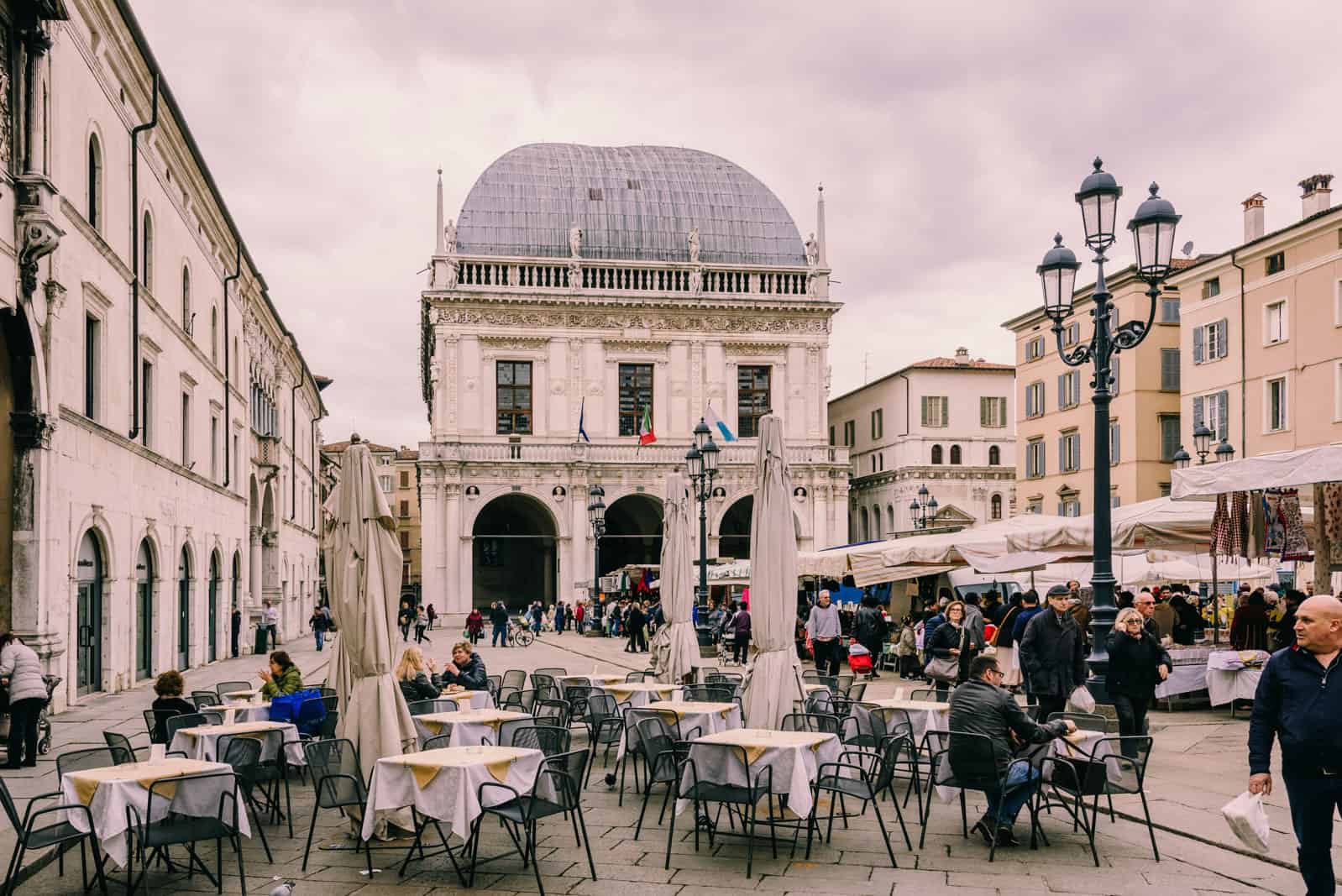





Ambivere | Rural Lombardy
Walk or run | Loop trail | 11km
Rural Lombardy
We were actually just trying to work off a large DOP pizza from the night before on this run near Ambivere but instead were spoilt with the beauty of rural Lombardy.
Our first point en route, up Via Santuario, a gravel road with no traffic, was Santuario Beata Vergine del Castello.
This beige-coloured church with a steeple made of natural stone masonry at its side, sits on a small elevation just outside Ambivere in midst of vineyards and pastures with views of the valley from a border of trees lining the lawn.
Their branches still naked but in spring mode, putting forth glossy new shoots and light green buds, threw an alley of shadows across the steaming grass coated in a layer of dew that evaporated in the sun. Not just the budding trees announced warmer days but also a white and green carpet of ‘lily of the valley’ covering the crunchy leaves dropped on the forest floor in autumn. We loved this route through fields, vineyards and woods, across cobble stone paths, and past a gurgling creek and it also seemed to be a favourite with the local running and walking community of whom we met at least two dozen on this Easter Sunday morning, working out before the anticipated family feasts.
When we returned, an outstanding breakfast awaited us, which in Italy is a rare treat. Italians usually nurse a cappuccino or latte for breakfast and nibble on biscuits or a croissant (this is the only time of the day when drinking coffee with milk is not frowned upon) and breakfast options even at 5-star hotels are surprisingly limited. Guiseppe instead sneaked in while we were still either asleep upstairs, showering, or out running and laid out a feast. On the dining table and kitchen worktops laden with plates of delicious homemade cake, croissants and pastries, muesli, fresh fruit, bread, homemade jams, and a large selection of cold cuts and cheese was enough food to feed an army.
With that many dishes to try, breakfast was a lengthy affair, but eventually we set off again to discover Bergamo on a leisurely walk that was without doubt my personal highlight of this trip and rounded off this Easter weekend well before we returned to Switzerland the next day.
track details.
Distance: 11km
Time: 1 hour
Elevation gain: 300m
Start/End: Bed & Breakfast Palazzo della Contessa
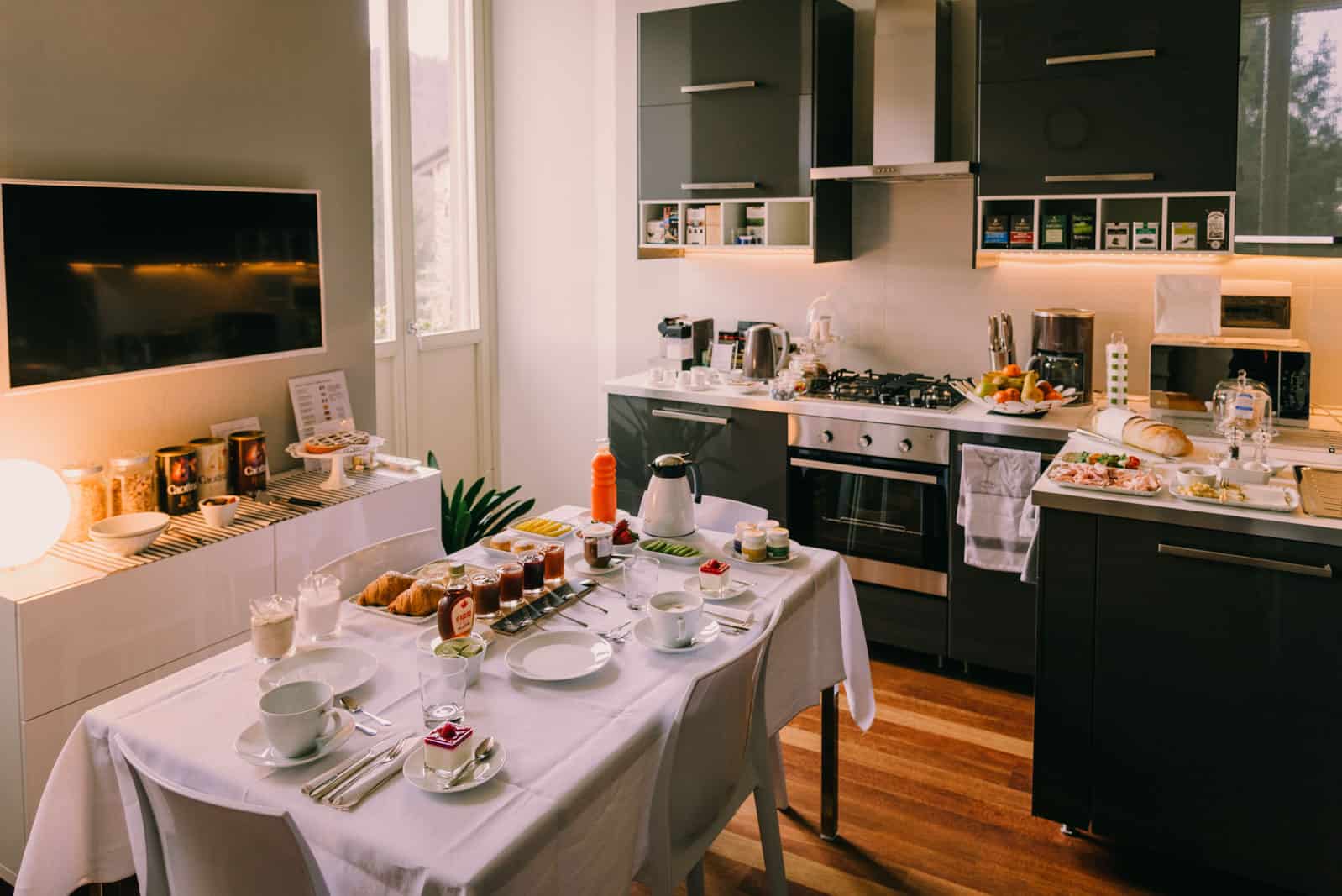



Walking tour | Bergamo
Walk | Loop trail | 12.3km
Walking Tour of the medieval Citta Altà of Bergamo
It is the Celts, who are thought to have founded the ancient settlement of “Berg-heim” at the foot of the pre-Alps between the Serio and Brembo rivers that was granted Roman municipality status as the town of “Bergamum” in 49BC and today is known as Bergamo. Despite changing hands several times, from the Romans to Lombard duchies, Charlemagne, and the Milanese Visconti among many others, its Città Alta, the old part of town surrounded by fortified walls, elevated above the plains of Lombardy luckily remained undamaged by various wars and battles.
It’s now one of the region’s finest medieval towns that revealed its beauty to us on this 4-hour, 12km walk that came highly recommended by our hosts. But they forewarned us that this route, on Easter Sunday, would also be very popular with the locals and indeed, we were continuously greeted with a cheerful “Buona Pasqua” by large groups of extended families catching some fresh air after lunch. We set off from the tiny hamlet of Villino (spacious car park free of charge) that is separated from Bergamo in the northwest by serene rural landscape and suburbs proclaiming their wealth by the many sizeable wrought-iron gates allowing an occasional glimpse of sprawling mansions behind them.
After an hour of walking and gaining 200m in elevation, the ruins of Castello di San Vigilio came into view. The castle that was once the residence of Bergamo’s ruling elite is still a popular destination thanks to its elevated location with spectacular views of the Old Town of Bergamo, itself raised above the Lower City on the Lombard plains, and is easy accessible via a cable car that connects the old city with the top of San Vigilio Hill.
We preferred the short downhill walk to the cable car however and entered the old city by Porta Sant’Alessandro town gate near the lower cable car station and continued clockwise along the massive Venetian Walls that date back to 1561 and still enclose the Upper Town. Wandering around atop these vast fortifications was a fleeting glimpse into days long gone, back when Walt Disney didn’t own all the kings and castles.
At Porta San Giacomo we dove back into the crisscross of tiny alleyways inundated with a cheerful crowd pouring out of every single restaurant that, according to Paolo, on Easter Sunday are fully booked months in advance. A few years ago I was surprised to learn that family celebrations in Italy, unlike in Germany or New Zealand, normally take place in restaurants not at home.
But ever since our Italian friends explained to us that homes in urban Italy are often too small to hold large family gatherings, eating out made sense. The maze of narrow roads blocked out the sun until we hit Piazza Vecchia, one of the few open spaces in the heart of the Città Alta framed by historic buildings such as Palazzo della Ragione, the municipal seat, and Torre del Campanone bell tower.
The red cobblestoned Renaissance square is neatly partitioned into squares by grey stone bricks that highlight the Contarini Fountain at its centre and the restaurants and cafes lining the piazza, their outdoor tables spilling into the square, pulled the crowd like a magnet. As was to be expected all tables were taken, but gelato and paninis were best eaten sitting on the steps to the Duomo in Piazza del Duomo anyway. This smaller square, just behind Piazza Vecchia, is enclosed by the Red Lions Portal of Santa Maria Maggiore Basilica (its ornate interior is also worth visiting) and the Colleoni Chapel with an elaborate Renaissance façade of white and red marble.
Once we’d eaten and were overwhelmed by the visitors surging across the sun-blasted cobbles, we withdrew to a quieter area and continued in a little circle to Piazza Rosate and the Southern entrance of the Basilica, this portal guarded by lions of white marble. We exited the Upper Town through Porta Sant’Alessandro to return to Villino and decided to walk via Monastero di Astino.
This recently renovated former monastery in the Astino Valley is set in pastures and surrounded by wooded hills dotted with magnificent villas that even from a distance radiated a distinguished elegance as they spilled down into the valley.
track details.
Route: Villino/Sombreno – Catello di San Vigilio – Città Alta Bergamo (Venetian Walls, Porta San Giacomo, Piazza Vecchia, Campanone, Cattedrale, Basilica di Santa Maria Maggiore) – Monastero di Astino (Chiesa del Santo Sepolcro)
Distance: 12.3km
Time: 4:20 hours
Elevation gain: 420m
Start/End: Via Sombretto between Villino and Sombrenoloop
